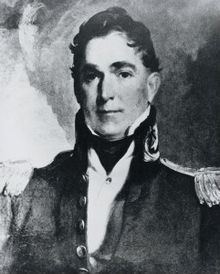Name Charles Gratiot Parents Charles Gratiot, Sr. | Years of service 1806–1838 Commands held Chief of Engineers | |
 | ||
Rank ColonelBrevet Brigadier General Place of burial Calvary Cemetery, St. Louis, Missouri, United States | ||
Battles and wars Battle of Mackinac Island | ||
Charles Chouteau Gratiot (August 29, 1786 – May 18, 1855) was born in St. Louis, Spanish Upper Louisiana Territory, now the present-day State of Missouri. He was the son of Charles Gratiot, Sr., a fur trader in the Illinois country during the American Revolution, and Victoire Chouteau, who was from an important mercantile family. His father became a wealthy merchant, during the early years of St. Louis. After 1796, Charles was raised in the large stone house purchased by his father in St. Louis, near the Mississippi River.
Contents
- Military career
- Chief of Engineers
- Late life and death
- Family
- Death and Legacy Tributes and memorials
- References
Military career
President Thomas Jefferson personally appointed him (and 3 other young Missouri men) as a United States Military Academy cadet in July 1804. The U.S. Military Academy at West Point, New York, was the first school of engineering in the United States and graduated its first class in 1802. Gratiot was a member of the Class of 1806, the fourth graduating class, and was commissioned in the Corps of Engineers. He became a captain in 1808 and assisted Alexander Macomb in constructing fortifications in Charleston, South Carolina. He returned to his alma mater in 1810 to be commander of the Army garrison at West Point during 1810–1811.
As General William Henry Harrison's Chief Engineer in the War of 1812, he distinguished himself by planning and building Fort Meigs in 1813. He also rebuilt Fort St. Joseph, later renamed Fort Gratiot in his honor. In 1814 he took part in the attack of the Battle of Mackinac Island. He received the Thanks of Congress for his efforts during the war.
He served as Chief Engineer, 1817–1818, in Michigan Territory followed by assignment as the superintending engineer, 1819–1828, for the construction of defenses at Hampton Roads, Virginia.
Chief of Engineers
On May 24, 1828, Gratiot was appointed colonel of engineers, brevet brigadier general, and Chief Engineer. For ten years he administered an expanding program of river, harbor, road, and fortification construction. He also engaged in a lengthy dispute with War Department officials over benefits, and in 1838 President Martin Van Buren dismissed him for failing to repay government funds that had been entrusted to him.
He assigned Robert E. Lee to do engineering in the Mississippi River at St. Louis, Missouri.
Late life and death
Gratiot became a clerk in the General Land Office from 1840–1855 and died in St. Louis.
Gratiot became a party to lengthy litigation against the United States government, which was appealed twice to the U.S. Supreme Court.
Family
He married Ann Belin on April 22, 1819. They had two children:
